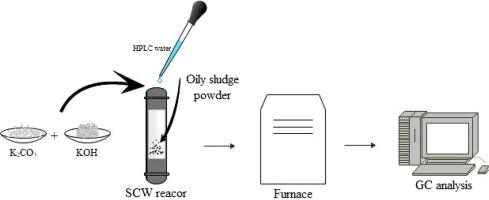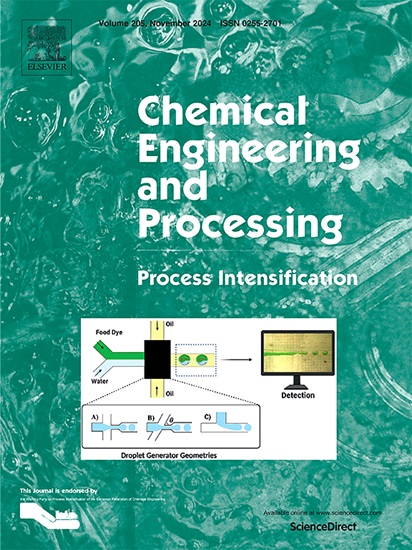H2-rich gas production from gasification of oily sludge via supercritical water technology: Synergy effect of KOH, K2CO3, and reaction parameters
IF 3.8
3区 工程技术
Q3 ENERGY & FUELS
Chemical Engineering and Processing - Process Intensification
Pub Date : 2024-09-27
DOI:10.1016/j.cep.2024.110008
引用次数: 0
Abstract
Yielding H2 as a sustainable gaseous fuel from oily sludge is of critical importance in mitigating the environmental effects linked with the usage of conventional fossil fuels. The deficiency in the drying of biomass has ensued to the exploration of supercritical water gasification (SCWG) as an effective method for harvesting H2-rich gas. This study utilized a combination of two alkali catalysts (KOH and K2CO3) in supercritical water to generate a H2-rich gas from a conventional oily sludge. The Box-Behnken design was utilized to assess the impact of different operational variables, including temperature (400–600 °C), feed concentration (FC) (between 5 and 25 wt.%), residence time (RT) (15–45 min), and catalyst to feed mass ratios (FMR) (0–0.50). The maximum production of H2 at 3.22 mmolg-feed-1 was achieved under optimal conditions of 600 °C, 32.76 min, and a KOH to FMR of 0.45 and K2CO3 to FMR of 0.28.

通过超临界水技术气化含油污泥产生富含 H2- 的气体:KOH、K2CO3 和反应参数的协同效应
从含油污泥中提取 H2 作为可持续的气体燃料,对于减轻使用传统化石燃料对环境造成的影响至关重要。由于生物质干燥过程中存在的不足,人们开始探索超临界水气化(SCWG)这一获取富含 H2 气体的有效方法。本研究利用超临界水中两种碱催化剂(KOH 和 K2CO3)的组合,从传统的含油污泥中产生富含 H2- 的气体。采用盒式贝肯设计评估了不同操作变量的影响,包括温度(400-600 °C)、进料浓度(FC)(5-25 wt.%)、停留时间(RT)(15-45 分钟)和催化剂与进料的质量比(FMR)(0-0.50)。在 600 °C、32.76 分钟、KOH 与 FMR 之比为 0.45 和 K2CO3 与 FMR 之比为 0.28 的最佳条件下,H2 的最大产量为 3.22 mmolg-feed-1。
本文章由计算机程序翻译,如有差异,请以英文原文为准。
求助全文
约1分钟内获得全文
求助全文
来源期刊
CiteScore
7.80
自引率
9.30%
发文量
408
审稿时长
49 days
期刊介绍:
Chemical Engineering and Processing: Process Intensification is intended for practicing researchers in industry and academia, working in the field of Process Engineering and related to the subject of Process Intensification.Articles published in the Journal demonstrate how novel discoveries, developments and theories in the field of Process Engineering and in particular Process Intensification may be used for analysis and design of innovative equipment and processing methods with substantially improved sustainability, efficiency and environmental performance.

 求助内容:
求助内容: 应助结果提醒方式:
应助结果提醒方式:


